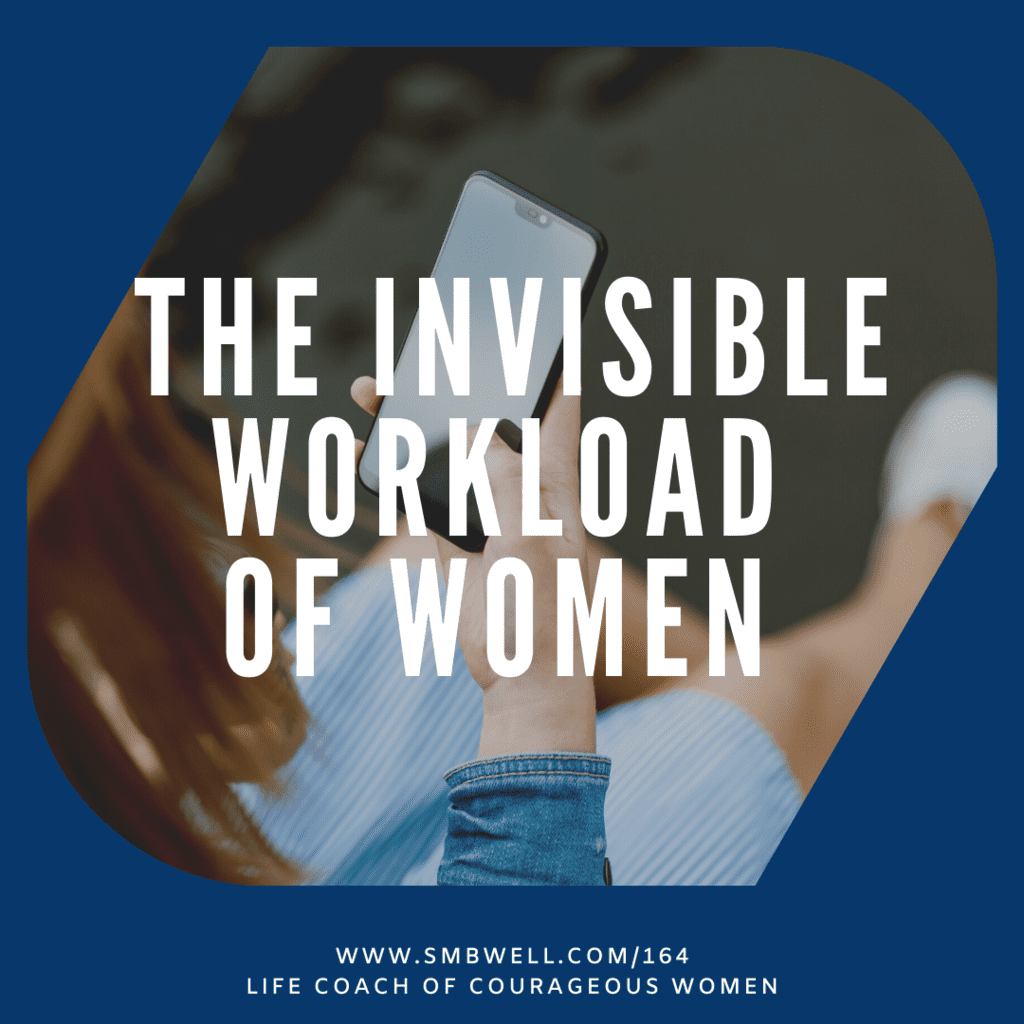Podcast: Play in new window | Download
Subscribe: Apple Podcasts | Spotify | Amazon Music | RSS | More
The Invisible Workload of Women
What is the invisible workload? It’s all the extra work that women do to make sure the household runs smoothly and the other people in their life are safe, nurtured, and comfortable.
Often, we take on this additional workload unconsciously without even realizing we’re doing it. Maybe our mothers modeled this behavior. Movies and society certainly does.
Therefore we step up and do it. We are usually thinking something like: “If I don’t, who will” or “No one else can do it as well as me” or “It’ll take too long to explain it to someone else.
Want Things to Change? Change Things
Great example of the thought model. Choose one of those above thoughts. For example: “No one can do it as well as me”. When I think that, I feel responsible, I do the action, and guess what? The result proves my thought true. No one else can do it as well as you. However, it is helpful to note that this is not a truth or fact, it’s rather a consequence of our actions: doing it all.
Push Pause
Listen in to this episode to learn small steps you can take to begin to shift out of this. Let’s learn how to stop doing it all. How the invisible workload affects women and how we can stop over functioning. Even more importantly, we can begin to feel better; to not feel so alone and overwhelmed. It is possible.
Examples of the Invisible Workload of Women
- You are the one person in the house who remembers to buy toilet paper when it’s running low.
- You’re one who keeps track of birthdays, doctor’s appointments, and all the other details of life.
- You’re the gatekeeper of all household information (“Mom, where do we keep the extra cereal?” “Where are my soccer cleats? “Where are the bandaids?” ).
- If we put a meter in your head to measure the mental energy you expend to keep your family fed, clothed, housed, organized, and functioning it would be in the red.
If You Want To Change, You Get To Change
If you’re listening in real time, I’m going to be captain obvious here – no one else is going to change it except for you. Another school year has started. Patterns are underway. The other humans in your life are well served by you taking care of the invisible workload. They get to open the cabinet and choose from a variety of cereals, they get to open their drawers and have clean clothes, They get to yell from their chair for more batteries.
Since you already have enough to do, I want to keep this simple. We have the tendency to talk ourselves out of things we think are too hard or too much of a change. Therefore today I bring you four options of ways to move from the stress and overwhelm caused by the invisible workload of women.
If It’s Meant To Be, It’s Up To Me
1. Stop the Auto Pilot
First become aware of the moments when you go on auto-pilot and take on the invisible load. Be that kind, curious observer of yourself. Notice your inclination to auto fix and pause to be curious. I like to say something in my head like: “huh, isn’t this interesting”. Bonus star if you Stop. Yes you heard me. Second step is to stop the auto-pilot acceptance of the invisible workload for women. Stop picking up, straightening, sending your grown ass husband a reminder that his mom’s birthday is next week. Stop.
2. Household Guidelines
In order to stop the invisible workload of women, we need to set up structure and guidelines. If you want specific examples of what this may look like, listen to the podcast episode. Together with clear, concise communication, house guidelines and structure help many erase the invisible workload of women. Choose to not pass down the legacy of rushing women syndrome by setting up something different.
3. Learn a New Language
Here is a great opportunity to practice a new way of being in order to reduce the invisible workload of women. I practice by standing in front of a mirror so I can make these phrases part of my daily vocabulary. I notice that when I read them (without practicing) they feel very uncomfortable. In reality it is uncomfortable. We have been trained by society and patriarchal programming to operate in a different way. Practice to pass down something other than the invisible workload of women:
- “You can handle this.”
- “You can figure that out on your own.”
- “My phone will be on silent while I’m working.”
- “Please don’t interrupt me unless someone is bleeding.”
- “I trust you to make the right decision. You don’t need to consult me.”
- “There’s a list of important household info and phone numbers on the fridge. Please read that instead of interrupting me while I’m working.”
4. Patience
Above all, this is an invitation to be patient with yourself. If you’re female, you most likely have a deeply-ingrained tendency to drop everything, ignore your own needs, and put other people first. It takes time to wean yourself off this habit. I’m still working on it. I’m consistently catching myself over functioning, and asking myself “did someone ask you to do this?” Or “is this something that could be done by someone else?” Be patient while continuing to pass off some of the workload. Keep at it.
The more you lessen the weight of the invisible workload of women, the better you will feel. The nicer a mom you’ll be. The less resentment you’ll feel towards your spouse. Bonus? You’ll have more energy. More time for yourself and your goals. More capacity to focus on things that really matter—like the quality of your relationships, the way you’re spending your days that’s in alignment with your purpose here on earth, modeling something other than a rushing women syndrome. This can feel scary. Regardless, get started. Get support to get started and get started.
Head to the free Warrior Women group and tell me: What’s one way you can reduce your invisible workload this week?
Resources Mentioned:
SUPPORT the Love Your Life Show
Interview on YouTube with Gemma Hartley
Show notes to Gemma’s Interview where you can get her book and her Ted Talk








